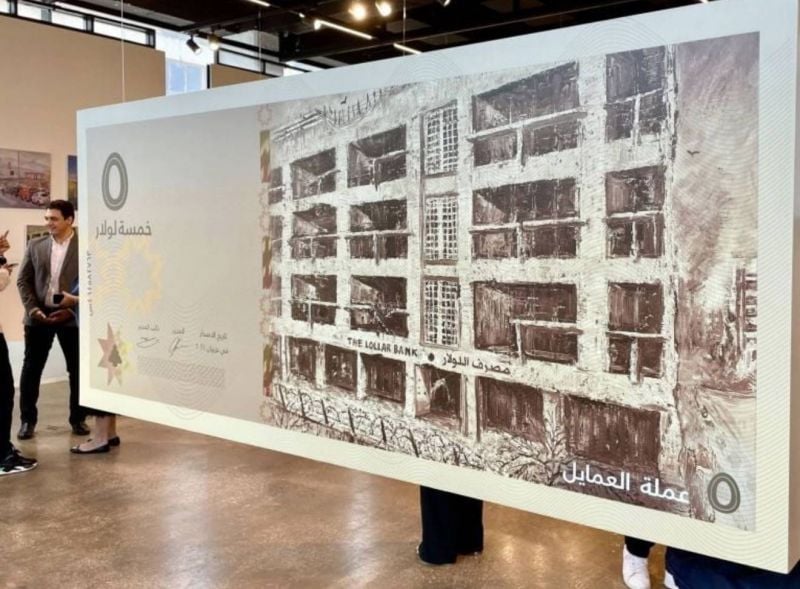
One of the fake lollar banknote designs imagined by artist Tom Young and presented in May 2022 by the Lebanese Transparency Association. (Credit: PHB/L'Orient Today)
Najib Mikati’s caretaker cabinet is planning to set the exchange rate for dollars stuck in the banks, also known as lollars, at LL25,000, two banking sector sources familiar with the file told L’Orient-Le Jour, confirming what local media reported over the weekend.
The sources added that Banque du Liban (BDL), which seeks to turn the page on the presence of multiple exchange rates once and for all, did not agree with the initiative.
The thorny issue was debated during the Jan. 26 parliamentary session set to vote on the 2024 budget. Heated exchanges ensued after MP Ali Hassan Khalil, a key member of Nabih Berri’s Amal Movement, proposed to increase the exchange rate of the lollar from LL15,000 to LL25,000. Independent MP for Baalbek, Jamil al-Sayyed, opposed that parliament take on this responsibility, considering that it is up to the cabinet to take such actions.
Mikat’s cabinet wants caretaker Finance Minister Youssef Khalil to set the lollar — dollars blocked by the illegal banking restrictions that have been enforced since autumn 2019 — rate at LL25,000 to the dollar. Unlike the lollar, “fresh” dollars are not subject to the same restrictions, having entered the economy after the start of the crisis.
Previously, the withdrawal rate of lollars was aligned with the official parity of LL15,000 to the dollar, introduced on Feb. 1, 2023, but today, that rate is de facto obsolete.
Basic Circular No. 151 which regulates the withdrawal of the lollar at the rate of LL15,000 expired at the end of 2023. Since Feb. 2, BDL has required that banks convert several categories of foreign currency assets denominated in foreign currency at a rate they did not specify. The recently passed 2024 budget law does not refer to the LL15,000 rate.
Neither is there reference to the LL15,000 rate on BDL’s website, pending the endorsement of the market rate at LL89,500 to the dollar, as the sole reference.
The cabinet’s desire to introduce an intermediate rate set at LBP 25,000 to the dollar goes against what the BDL has been trying to put in place and what the International Monetary Fund has recommended.
The reason given for this initiative is that many depositors need liquidity in lira and the banks cannot pay them their deposits at the rate of LL89,500 because they lack sufficient liquidity in lira. Setting the lollar at LL25,000 implies that each dollar withdrawn from accounts that have been blocked by the restrictions would only cost the bank $0.28 when disbursed in lira to its customer, i.e. a haircut of 72 percent compared with the current market rate.
One of the above-mentioned sources said the LL25,000 rate is but one possible option. The cabinet is pressing for an intermediate rate of LL25,000 or LL30,000. It was also suggested to set the rate at LL45,000, but there is little chance for it to be approved.
The same source added that the cabinet hopes to strictly control withdrawals, with “weekly and monthly ceilings,” to prevent any exchange rate instability that lira injections could cause. BDL has been maintaining the exchange rate mainly by limiting the quantity of currency on the market as much as possible. The limit under discussion would range between LL10 to LL15 million per month or $112 to $167. It is in line with the $150 monthly limit that depositors subjected to the restrictions can withdraw through BDL Circular No 166, published on Feb.2
The cabinet’s plan raises many questions, the initial answers to which will begin to emerge in the coming weeks:
-Why does the cabinet want to pass a measure that is opposed by BDL, but supported by at least one of the country’s major political parties?
-Is the party or parties involved seeking to meet the demand of a section of depositors who want to be able to withdraw more money from accounts, or of the banks that do not want to be forced to repay deposits at the market rate?
-If this measure is passed, will BDL and the authorities have the means to continue to keep the exchange rate stable?
-What impact will this measure have on the banking sector restructuring draft that the cabinet plans to examine on Thursday?
-What is the IMF’s take?
The BDL, the caretaker finance minister and Mikati’s press office have not responded to L’Orient-Le Jour’s requests for answers.
This article was originally published in French in L'Orient-Le Jour. Translation by Joelle El Khoury.